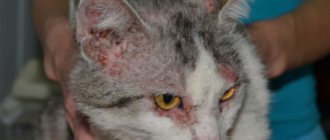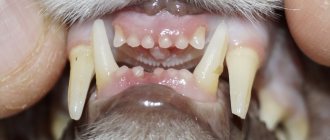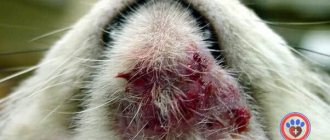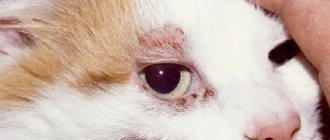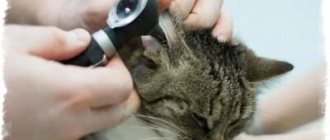Alena Igorevna Goncharenko
veterinarian Petstory
Skin diseases in cats are very common in veterinary practice. Such patients account for at least 30% of all types of visits to the clinic for help. To describe the condition of a pet's skin, owners usually use popular terms such as “sores,” “scabs,” “wounds,” and “ulcers.” In this article we will use the same terms for a better understanding and try to figure out why such problems arise and how to deal with them.
The main symptoms and manifestations of skin diseases in cats
Many skin diseases can present with very similar symptoms. You can often see bald patches, wounds, and scabs on the animal’s body. But some diseases have distinctive features, which, when seen, can make a preliminary diagnosis.
- Bald lesions on a cat's body can be found with lichen and demodicosis.
- A large number of scales similar to dandruff are observed when infected with the Cheyletiella mite.
- Wounds with crusts in the scalp area are noted with itching, which is often due to allergies.
- Skin ulcers on a cat's body can be found due to deep skin infection, thermal or chemical burns.
- Black spots on the chin are a sign of feline acne.
- Small crusts on a cat’s skin may indicate miliary dermatitis, which is how the cat’s body reacts to an infection or allergen.
- Pimples with white contents can occur with autoimmune diseases or superficial bacterial infections.
Skin infections
Scratched cat sores on the neck and head in some cases occur due to infectious diseases. Cats with access to the outdoors are especially susceptible to them. When a bacterial infection of the skin occurs, one of two forms develops:
- Dry. Dry crusts, dandruff and scabs form on your cat's neck.
- Wet. It is characterized by the appearance of blisters and ulcers with liquid contents inside.
Animals with sensitive skin are predisposed to eczema. It develops through prolonged contact with flea collars, harnesses, after insect bites and skin parasites.
Important! Diabetes mellitus, neuropathy and hormonal changes contribute to the appearance of eczema.
A rash and blisters appear on the pet's body. Severe itching leads to the cat scratching its neck until it bleeds, and sores appear that do not go away for a long time. To eliminate eczema, antibacterial therapy, various ointments and powders are prescribed.
Viral dermatoses
Cat scratching on the skin is also characteristic of viral dermatoses. The herpes virus affects the eyes and respiratory tract of the animal, often manifesting itself as skin lesions. They are often localized in the area of the nose and eyes, less often on the paws and stomach.
Feline herpes is characterized by:
- bloody stains;
- small rash;
- swelling of the skin;
- small scabs on the neck, sores on the head.
Skin changes appear 1.5 weeks after the disappearance of conjunctivitis and other characteristic symptoms.
Cowpox or poxvirus is a rare disease. It can enter the cat's body through the bites of small rodents. It manifests itself as skin lesions in the form of nodules and small ulcers. With good immunity, it goes away on its own. In weakened animals there is a risk of developing a severe form.
Autoimmune dermatoses
Autoimmune diseases are characterized by an abnormal reaction of the immune system to its own tissues and cells. Skin manifestations on the body of cats are characteristic of several diseases:
- Common pemphigus. It is characterized by the development of ulcers in cats around the mouth and in its cavity itself. Involves long and difficult treatment. It often ends critically for animals.
- Erythematous pemphigus. Crusts, ulcers, blisters, sores and other lesions are concentrated in the area of the animal’s nose and bridge of the nose. Sometimes the disease is accompanied by a change in skin color.
- Pemphigus foliaceus. The main symptom is the appearance of large pustules on the skin near the mouth and ears. Associated signs in cats include elevated body temperature, refusal to eat, and apathy.
- Systemic lupus erythematosus. It affects all systems and organs of the animal. Wounds on the scalp manifest themselves through depigmentation of the skin, the development of a rash and the subsequent formation of ulcers.
Diagnostics
A preliminary diagnosis can only be made based on the results of the examination, since the diseases have characteristic clinical signs described above. Additional studies are required to confirm the diagnosis. To exclude the presence of a bacterial or fungal infection, a cytological examination of skin smears is performed. Also, thanks to it, you can see the cells that appear in autoimmune diseases. Autoimmune disease is confirmed using skin histology. Using scrapings, in most cases it is possible to detect skin mites, but the Demodex gatoi mite is very rarely found in scrapings, and this disease is not easy to diagnose. Several methods can be used to diagnose lichen. First, the animal is examined under a fluorescent lamp - this method makes it possible to detect lichen in 50% of cases, since not all types of this infection will glow under the lamp. Then trichoscopy can be performed, thanks to which you can see the hairs destroyed by fungal spores. A more accurate diagnosis is to inoculate hairs in special growth media. Fungi in such environments can grow for a long time, up to 3-4 weeks, but the accuracy of this diagnosis is at least 95%.
Most often, identifying an allergen is not an easy task; there are no special tests for this. First, using scrapings, cultures, etc., it is necessary to exclude all possible differential diagnoses, which will be suggested by the doctor. If allergy remains the most likely diagnosis, the stage of excluding possible allergens will begin. First of all, fleas are excluded, the animal and the room where it lives are treated. A special elimination diet may then be prescribed to rule out food allergies. If the allergen is not identified, a diagnosis of “non-food allergy” or “atopy” is made.
Ectoparasites
Human flea dermatitis
Most often, cats suffer from flea attacks. The saliva of blood-sucking insects causes an allergic response characterized by itching. The pet scratches the affected area and flea dermatitis develops.
Microorganisms - permanent inhabitants of the skin - join. The inflammatory process develops according to the scheme described above. Skin parasites - Heyletiella mites feed on the epidermis, causing itching and scratching. Ectoparasites pose a danger to humans. Adult fleas attack people and bite painfully. The larvae crawl from the litter to open areas and feed on the epidermis.
But the greatest harm to humans is caused not by the insects themselves, but by the pathogens of the following diseases, transmitted by all phases of arthropod development:
- brucellosis;
- anthrax;
- typhus;
- helminths;
- tick-borne encephalitis.
Cheyletiella are not so harmful, however, children or old people develop itching after contact with a pet. Ticks cannot stay on cold, hairless human skin for long. If you interrupt contact with your pet, the itching disappears. When restarted it appears again.
Although the biology of parasites is different, the measures to combat them are the same. Adult arthropods and larvae are destroyed with an insectoacaricidal spray. After 8-10 days the treatment is repeated.
Drops of Stronghold
Eggs are immune to poisons. After 8-10 days, the larvae hatch from them, so you need to destroy them before they become sexually mature. External anti-inflammatory wound healing agents are applied to the damaged surface. To speed up healing, pets are switched to veterinary food for cats with skin diseases.
Prevention consists of regular use of Spot-on drops, which protect against ectoparasites and worms.
Treatment of skin diseases in cats
If bacterial or fungal flora is detected in the affected areas of the body, local and systemic drugs, various antibiotics and antifungal agents are prescribed. If the cat is good at washing, bathing with antibacterial shampoos is convenient. Skin mites are treated with antiparasitic drugs. Recently, modern preparations in the form of drops on the withers have been used for this; they are highly effective. Autoimmune diseases are treated with drugs that suppress the immune system - immunosuppressants. Such drugs can be prescribed either as a course or on an ongoing basis. To treat allergies, it is necessary to identify the allergen and eliminate it from the animal’s life. But this is not always possible. Otherwise, drugs against itching and inflammation are used. If your pet's allergies are seasonal, then the tablets should be taken only during the period of exacerbation. If the allergy is constant year-round, then the drugs will have to be used for life, trying to choose the minimum effective dosage. To treat psychogenic itching, sedatives and antidepressants are used.
Preventive methods
If the kitten's skin is covered with sores and the affected area is gradually expanding, you need to make an appointment with a veterinarian as soon as possible and undergo a comprehensive examination, since the causes of the rash can be varied - from scabs to endocrine disorders.
As a preventive measure, you should monitor your pet’s hygiene, get standard vaccinations according to plan, and establish a nutritional and drinking regime. If a cat is prone to allergies, it is important to identify and eliminate the irritating factor, otherwise drug therapy will not bring results. You should not self-medicate. Sometimes the improvised drugs used do bring relief, but not for long, since eliminating the symptoms does not affect the root cause of their occurrence. Only a properly selected comprehensive therapy regimen will help cure your pet from skin problems and prevent complications.
Prevention
The main methods of preventing skin diseases in cats include regular antiparasitic treatments. Using drops on the withers, even for domestic cats, allows you to avoid many unpleasant situations associated with infestation with fleas and ticks. The contact of a domestic cat with stray animals should be limited. It is necessary to organize the pet’s living environment in such a way that it does not need anything and does not experience chronic stress. Stress can lead not only to psychogenic itching, but also to a decrease in the overall immunity of the body.
Fleas
Blood-sucking parasites (aka fleas) are quite capable of causing sores under the fur on a cat’s neck, and this is one of the most common causes. Insects, whose favorite place is the neck area, bite the animal, which causes severe itching. The cat begins to itch and scratches the bites, turning them into wounds. The situation will only get worse if action is not taken.
With dirty claws, an animal can introduce an infection into the sore, which can lead to purulent inflammation. In addition, the scratched area will attract even more fleas, and they are known to be carriers of all kinds of infection. To avoid serious complications, you need to fight the parasites and only then begin treatment. Today there are a huge number of different flea remedies available :
- special collars;
- pills;
- shampoos;
- sprays;
- powders;
- drops on the withers, etc.
When no trace of parasites remains, the wounds are treated with peroxide, iodine or other antiseptic. If there are purulent formations, you cannot do without the help of a veterinarian and more serious medications.
© shutterstock
Can a person get infected from a cat?
Most skin diseases in cats are not transmissible to humans and are only contagious between felines. Ringworm is potentially contagious to humans, and children, the elderly and people with weakened immune systems are considered especially vulnerable. Adults most often do not become infected from cats. If you notice signs of lichen, you should immediately consult a dermatologist. Notoedrosis can cause pseudoscabies in humans, but the disease itself does not require treatment.
The cat has sores under its fur: Is the danger high?
The greatest danger comes from traumatic skin injuries. With the development of diffuse inflammation (phlegmon) or a more local abscess, sepsis can develop, which can lead to the death of the cat.
But in most cases, everything is not so scary, all dermatological diseases can be treated, although the time frame may be different. In the case of autoimmune diseases, lifelong medication is required.
Also, some causes of skin damage in cats can be contagious to other animals and people.
Blackness in a cat's ears: What is it and how to treat it? – https://strazhchistoty.ru/cleanup/cleancats/chernota-u-koshki-v-ushah.html
Fungal otitis media
The disease is an inflammation of the external auditory canal. The development of fungal otitis occurs due to a weakened immune system. The pet shakes its head and scratches its ear.
The ears turn red quickly and strongly. When examining the ear with an otoscope, severe inflammation of the skin and many fungal deposits are observed.
Every day you need to clean the ear of accumulated secretions with napkins and cotton swabs. Afterwards you need to treat them with alcohol-based antiseptics.
Possible causes of itching
Often, a domestic cat often washes and scratches its neck behind the ears, its muzzle, tears the skin on its head and scratches itself so that its hair falls out or sores appear until it bleeds and scabs and scabs, and to find out why this happens and how to treat it, first The first thing you need to do is check whether he has fleas or not.
If blood-sucking insects or their eggs are detected, you will need to immediately treat the animal’s fur with special preparations. Even after the parasites are completely eliminated, the body still contains the substance that entered the bloodstream during the bite. Its effect can last from 1 to 2 months, causing the cat to want to scratch the irritated area. If no fleas were found during examination of the animal, then the cause of the itching may be as follows :
- skin diseases;
- hormonal disbalance;
- allergic reaction;
- endocrine gland disorder;
- lichen;
- the presence of parasitic worms (helminths).
To eliminate itching and protect a cat living at home from scratching its neck, back and other places, it is necessary to identify the source of its occurrence and carry out effective treatment. Next, the possible causes of the disease are discussed and what to do if the cat often licks itself until it hurts, what to give if it is constantly itching.
Eczema
Eczema is an unpredictable disease.
Appears due to many factors, including:
- Severe skin contamination with parasites, dirt, bacteria;
- Improper wearing of collars and synthetic clothing for cats;
- Complication of any disease (pathology of the nervous system, kidney disease, stomach and liver).
The main symptom is a weeping surface of the skin. Scratching causes knots and redness to form. The cat is rapidly losing weight, has a fever and kidney problems.
For diagnostic purposes, the veterinarian will take a skin scraping to rule out the possibility of other diseases. Afterwards he should prescribe antihistamines. You should not try to treat your cat without a doctor, as complications may develop.
Tail gland hyperplasia
If the tail gland has increased hyperplasia, excessive accumulation of sebaceous secretion appears. It is released and envelops the hair at the point of growth, blocking its further development. Because of this, her hair falls out and areas of baldness appear.
Therapy involves monitoring the problem area. Castration can help cats.
Ear mites
Ear mites appear as a result of improper care. Symptoms: scratching, foul odor from the ears, dark gray discharge, redness of the skin of the ears, fever.
Treatment can begin after visiting a veterinarian. Various aerosols (based on Dermatosol or Tsiodrin), drops (Bars, Tsipam, Amitrazine) and ointments (Nicochloran, Phenothiazine) are used. Dark discharge should be removed with a soft cotton cloth or cotton wool.





